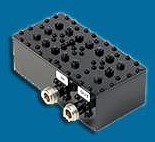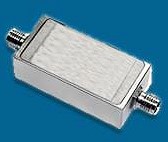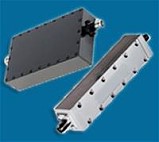
Sam Benzacar, the well-known head of Anatech Electronics, has boldly proclaimed
his predictions for the microwave industry in 2019. This deviates from his
traditional year-end newsletter that presented a wrap-up of the previous year's
happenings. Filter manufacturers like Anatech love RF spectrum growth and crowding
because it provides continuing opportunity to engineer solutions that help make
co-existence possible. The downside of these dense operational environments is that
spectral masks get more and more complicated and difficult to comply with in order to
meet certification standards, which places increasingly difficult requirements on
filters. That goes for both transmitters which must not exceed power output limits
and for receivers that must be able to function within electromagnetically noisy
areas. Signal processing does a lot of the heavy lifting, but ultimately physical
filters make or break a wireless system.
December 2019 Update: See Sam's "My Predictions for 2019: The Reckoning."
A Word from Sam Benzacar
 The RF and Microwave
Industry in 2019: My Predictions
By Sam Benzacar
Since I first began writing this column in 2008 (no doesn't seem like "just yesterday"),
so much has happened in the and microwave industry and high-tech in general. Back in
2008, the FCC just gave wireless carriers the green light to decommission their analog
networks, Apple introduced the iPhone 3, Google released the Chrome browser, Windows
7 was about to be released, Amazon began selling the Kindle, and netbooks were the rage.
Now, the cellular industry is promising gigabit-per-second downstream speeds (and,
incredibly, using millimeter wavelengths), the iPhone has reached its tenth generation
with a flagship phone that costs as much as a decent laptop computer (an iPhone 3 with
16 Gbytes of RAM cost $199), Chrome is now the browser, Windows 10 has been around for
nearly 4 years, I'm on my second Kindle Paperwhite, and the netbook is, thankfully, dead.
With a decade of end-of-the-year columns under my belt, I've decided that this time,
I'm going to make some predictions rather than taking the easy route and summing up the
previous year.
 5G: Last year, I wondered if the huge challenges
of using millimeter wavelengths would prove to be too much for the cellular industry.
I'm still not sure about that, but we'll soon find out as the first "5G" smartphones
with millimeter-wave capability are coming next year and the carriers are feverishly
deploying small cells to serve them. I still haven't come to grips (no pun intended)
with how well millimeter-wave signals are going to propagate with your hand around the
phone. The most visible application for 5G will be fixed wireless access (FWA) as competition
for cable with speeds of 1 Gb/s, maybe more. My prediction: The first 5G smartphones
will roll out from some vendors (but not Apple, which is wisely waiting until 2020) with
less-than-spectacular results, and FWA will be available in some places from Verizon
and AT&T. 5G: Last year, I wondered if the huge challenges
of using millimeter wavelengths would prove to be too much for the cellular industry.
I'm still not sure about that, but we'll soon find out as the first "5G" smartphones
with millimeter-wave capability are coming next year and the carriers are feverishly
deploying small cells to serve them. I still haven't come to grips (no pun intended)
with how well millimeter-wave signals are going to propagate with your hand around the
phone. The most visible application for 5G will be fixed wireless access (FWA) as competition
for cable with speeds of 1 Gb/s, maybe more. My prediction: The first 5G smartphones
will roll out from some vendors (but not Apple, which is wisely waiting until 2020) with
less-than-spectacular results, and FWA will be available in some places from Verizon
and AT&T.
IoT: Home automation is spreading its tentacles beyond applications
like HVAC, smart locks, and lighting: I was just at Home Depot and the shelves were full
of Bluetooth-connected Christmas decorations that you control with an app, for what that's
worth. Amazon and Google are on the IoT bandwagon in a big way, and it won't be long
before every car will have Alexa, Google Assistant, or both as optional and ultimately
standard features. But this is chump change for IoT because "smart" cities make this
look like a science project, and they are already here. Interestingly enough, Spain seems
to be leading this charge, with everything from garbage can sensors to parking and a
lot more. My prediction: IoT will begin to deliver on its promise in a big way this year.
Defense: Until 1990, this was the market for RF and microwave components,
and it's been steady business over the years. Now, DoD is in full-development mode owing
to technological advances in Russia and China. The Army, in particular, needs a decent
solution for battlefield communications as well as a huge investment in EW. My prediction:
2019 will be a very good year for field and waves.
 Wi-Fi: 5G needs more backhaul and Wi-Fi
is a (and perhaps the) solution. For the rest of us, routers for 802.11ax (now called
Wi-Fi 6 with downstream rates 37% faster than 802.11ac) are already shipping and the
technology should be in smartphones later next year. Not to be outdone at millimeter-wavelengths,
there's 802.11ad (Wi-Gig) and 802.11ay that operate at 2.4, 5, and 60 GHz to deliver
downstream rates of nearly 7 Gb/s. My prediction: 802.11ax products will be offered by
all major router manufacturers in a few months, and later in 2019 or possibly 2020 it
will be joined by Wi-Gig, which should actually be called Wi-Fi 7 as the Wi-Fi Alliance
has finally decided to make various Wi-Fi permutations easier to understand. Wi-Fi: 5G needs more backhaul and Wi-Fi
is a (and perhaps the) solution. For the rest of us, routers for 802.11ax (now called
Wi-Fi 6 with downstream rates 37% faster than 802.11ac) are already shipping and the
technology should be in smartphones later next year. Not to be outdone at millimeter-wavelengths,
there's 802.11ad (Wi-Gig) and 802.11ay that operate at 2.4, 5, and 60 GHz to deliver
downstream rates of nearly 7 Gb/s. My prediction: 802.11ax products will be offered by
all major router manufacturers in a few months, and later in 2019 or possibly 2020 it
will be joined by Wi-Gig, which should actually be called Wi-Fi 7 as the Wi-Fi Alliance
has finally decided to make various Wi-Fi permutations easier to understand.
ATSC 3.0: The next generation of over-the-air TV broadcast is almost
here, and it's nothing like what's available now. My prediction: Cord cutting will increasingly
combine this with broadband, putting and even bigger dent in cable subscriptions.
Rural Broadband: Millions of people in the U.S. and Canada have nothing
approaching "real" broadband, except for services provided by Wireless Internet Service
Providers (WISPs). My prediction: The government is throwing money at wireless carriers
to make serving rural areas fairly profitable, FWA eliminates the need to lay huge amounts
of fiber, and IoT is a new market opportunity. The result: More rural areas will finally
have broadband service and WISPs will need to up their game.
There you have it. Next year at this time, we'll all be able to see how well my predictions
hold up.
So… all of us here at Anatech Electronics wish
everyone best wishes for a wonderful holiday season, and good health, happiness, and
prosperity for the New Year!
Check out Our Filter Products



Cavity Band Pass Filters
LC Band Pass Filters Cavity Bandstop/Notch Filter
About Anatech Electronics
Anatech Electronics, Inc. (AEI) specializes in the design and manufacture of standard
and custom RF and microwave filters and other passive components and subsystems employed
in commercial, industrial, and aerospace and applications. Products are available from
an operating frequency range of 10 kHz to 30 GHz and include cavity, ceramic, crystal,
LC, and surface acoustic wave (SAW), as well as power combiners/dividers, duplexers and
diplexers, directional couplers, terminations, attenuators, circulators, EMI filters,
and lightning arrestors. The company's custom products and capabilities are available
at www.anatechelectronics.com.
Contact:
Anatech Electronics, Inc. 70 Outwater Lane Garfield, NJ 07026 (973) 772-4242
sales@anatechelectronics.com
Posted December 27, 2018
|






























 5G: Last year, I wondered if the huge challenges
of using millimeter wavelengths would prove to be too much for the cellular industry.
I'm still not sure about that, but we'll soon find out as the first "5G" smartphones
with millimeter-wave capability are coming next year and the carriers are feverishly
deploying small cells to serve them. I still haven't come to grips (no pun intended)
with how well millimeter-wave signals are going to propagate with your hand around the
phone. The most visible application for 5G will be fixed wireless access (FWA) as competition
for cable with speeds of 1 Gb/s, maybe more. My prediction: The first 5G smartphones
will roll out from some vendors (but not Apple, which is wisely waiting until 2020) with
less-than-spectacular results, and FWA will be available in some places from Verizon
and AT&T.
5G: Last year, I wondered if the huge challenges
of using millimeter wavelengths would prove to be too much for the cellular industry.
I'm still not sure about that, but we'll soon find out as the first "5G" smartphones
with millimeter-wave capability are coming next year and the carriers are feverishly
deploying small cells to serve them. I still haven't come to grips (no pun intended)
with how well millimeter-wave signals are going to propagate with your hand around the
phone. The most visible application for 5G will be fixed wireless access (FWA) as competition
for cable with speeds of 1 Gb/s, maybe more. My prediction: The first 5G smartphones
will roll out from some vendors (but not Apple, which is wisely waiting until 2020) with
less-than-spectacular results, and FWA will be available in some places from Verizon
and AT&T. Wi-Fi: 5G needs more backhaul and Wi-Fi
is a (and perhaps the) solution. For the rest of us, routers for 802.11ax (now called
Wi-Fi 6 with downstream rates 37% faster than 802.11ac) are already shipping and the
technology should be in smartphones later next year. Not to be outdone at millimeter-wavelengths,
there's 802.11ad (Wi-Gig) and 802.11ay that operate at 2.4, 5, and 60 GHz to deliver
downstream rates of nearly 7 Gb/s. My prediction: 802.11ax products will be offered by
all major router manufacturers in a few months, and later in 2019 or possibly 2020 it
will be joined by Wi-Gig, which should actually be called Wi-Fi 7 as the Wi-Fi Alliance
has finally decided to make various Wi-Fi permutations easier to understand.
Wi-Fi: 5G needs more backhaul and Wi-Fi
is a (and perhaps the) solution. For the rest of us, routers for 802.11ax (now called
Wi-Fi 6 with downstream rates 37% faster than 802.11ac) are already shipping and the
technology should be in smartphones later next year. Not to be outdone at millimeter-wavelengths,
there's 802.11ad (Wi-Gig) and 802.11ay that operate at 2.4, 5, and 60 GHz to deliver
downstream rates of nearly 7 Gb/s. My prediction: 802.11ax products will be offered by
all major router manufacturers in a few months, and later in 2019 or possibly 2020 it
will be joined by Wi-Gig, which should actually be called Wi-Fi 7 as the Wi-Fi Alliance
has finally decided to make various Wi-Fi permutations easier to understand.


